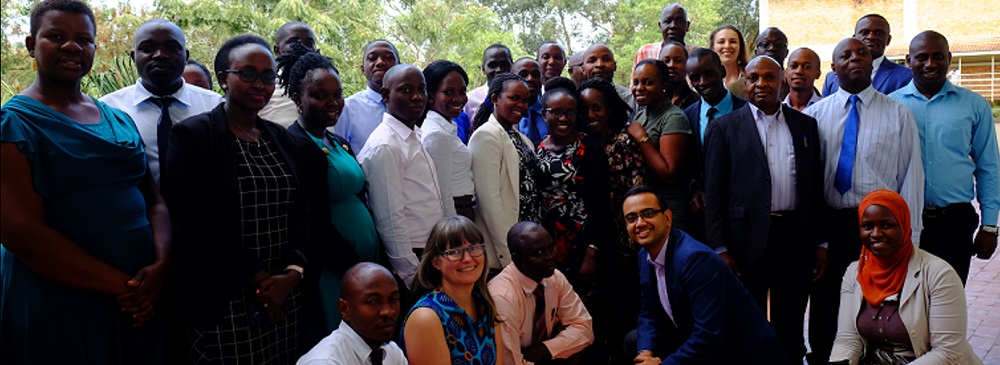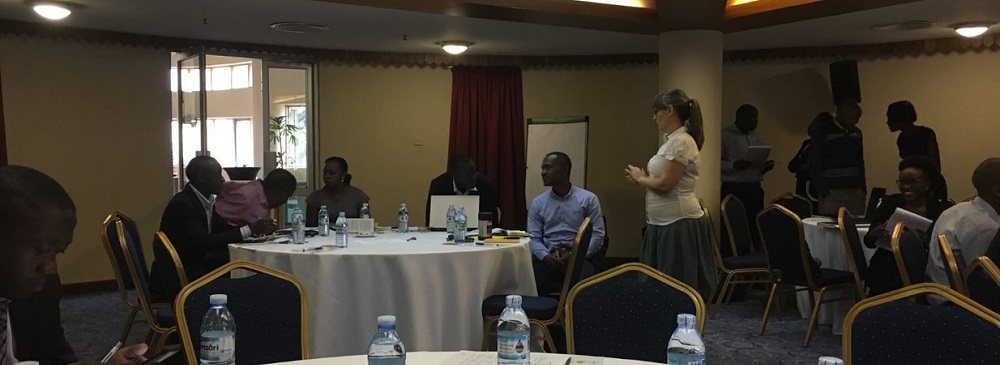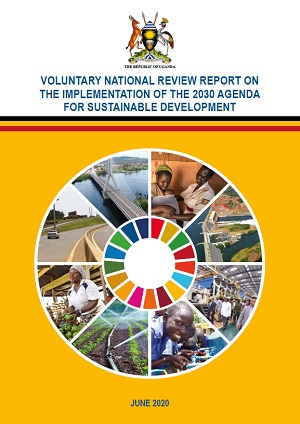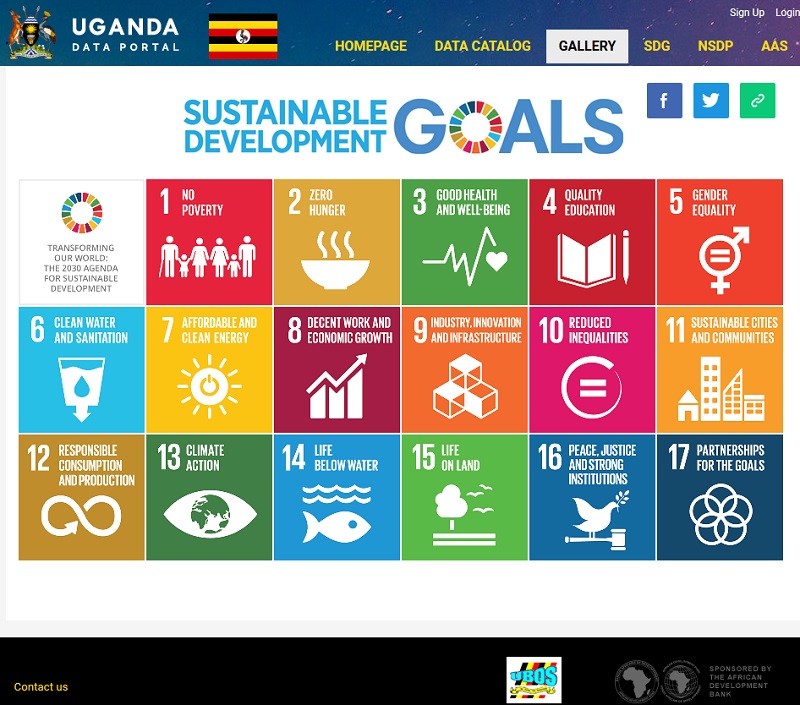Uganda
I. General on SDG monitoring set up
National SDG organizational set up
In 2016, the Government of Uganda developed a framework to guide the Coordination of the implementation of the 2030 Agenda and its associated SDGs under the leadership of the Office of the Prime Minister. This framework was approved by Cabinet and Parliament and it brings together all players both state and non-state actors including local governments to deliver on the SDGs and the 2030 Agenda.
The National SDG Coordination Framework provides for five multi-stakeholder Technical Working Groups (TWGs) comprising of Sector Working Groups (SWGs); Development Partners; Private Sector; and Civil Society. The TWGs are the backbone of the SDG Coordination Framework and they meet quarterly and submit the required reports to the SDG Secretariat to inform and drive SDG implementation in Uganda.
(References: https://opm.go.ug/sdgs/; Roadmap for Creating an Enabling Environment for Delivering on SDGs in Uganda)
National set of SDG indicators
Out of the 232 global indicators, 202 are relevant to the Ugandan context and 29 are non-applicable. Uganda’s National Statistical System (NSS) has the capacity to compile 85 global indicators out of the 202 applicable indicators, of which 45 indicators are fully available whereas 40 indicators are easily feasible to have data available. This put Uganda at a level of 42 percent (%) applicable indicators. The assessment of the availability of 39 indicators is pending. Once the pending indicators have been assessed, the percentage of available indicators is likely to increase.
The SDG on Climate Action (SDG13) has the highest share of indicators with available data, scoring 100%. Whereas the Goals on Innovation and Infrastructure (SDG9); Responsible Consumption (SDG12); and Peace and Justice (SDG16) are the three Goals with the least available indicators.
SDGs, National strategies and Implementation plans.
Uganda’s Vision 2040 is long-term document guiding the planning function of the government’s ministries with the overall goal to transition Uganda to a middle-income country by focussing on sustainable wealth creation, employment and inclusive growth.
Vision 2040 is clearly and fully aligned on SDGs along nine SDG targets across six goals. These targets are on
- Health (SDG 3)- in specific commitment to reduce stunting (3.4),
- Water and sanitation (SDG 6)-in specific on achieving water-efficiency (6.4),
- Economic growth and employment (SDG 8)-in specific on sustaining high GDP growth (8.1) and a focus on high economic productivity (8.2) as well as reducing the number of youths not in employment (8.6).
- Sustainable industrialisation (SDG 9)- in specific on development of regional and transborder infrastructure (9.1)
- Sustainable cities (SDG 11)-in specific on safe housing and upgrading slums (11.1) and
- Sustainable use of terrestrial ecosystems (SDG 15)- in specific on promoting afforestation and halting deforestation (15.2) and sustainable forest management (15.9b).
In the SDG targets above Vision 2040 is considered aligned because it highlights a pathway for achieving goals (e.g. it commits to increasing GDP through investment in productive industries). For the SDG targets above, it also embeds national indicators within the plan, to show how the government intends to measure progress on its commitment over time. The most significant source of misalignment in the Vision 2040 is the competing priorities of combating climate change and investment in renewable energy simultaneously with exploitation of fossil fuels and the construction of oil refineries in the country.
Vision 2040 in Uganda is operationalised by a series of five-year National Development Plans (NDPs) which set medium-term strategic direction for the country’s sectors and related ministries, departments and agencies (MDAs) which in turn are required to align all their work and plans to the NDP. In keeping with the emphasis in Vision 2040, NDP II prioritises investment in three key areas of wealth creation: agriculture (SDG 2), tourism (SDG 8) and minerals, oil and gas as well development in two areas of cross-cutting fundamental support: infrastructure and human capital. Flowing from these priorities the NDP II focuses on SDG targets related to economic growth, employment and decent work (per SDG 8) and building resilient infrastructure and industrialization (SDG 9), with accompanying investments in health (SDG 3) and education (SDG 4).
The NDP II is clearly aligned on SDGs along nineteen SDG targets across nine goals. However, there are a few development objectives that NDP II has taken the important step of recognising as significant but are recognised as weakly aligned in this exercise because the commitment in NDP II is currently missing a linkage between policy and outcome, corresponding budget allocation and/or tracking information.
SDG reports and Voluntary National Reviews
Uganda presented its first VNR to the UN High Level Political Forum in 2016, with a second in 2020. A key input to the 2020 VNR was the national SDG indicator matrix. The matrix was propulated through the input of statisticians from UBOS, ministries, departments and agencies, and was used by UBOS to update SDG reporting platform and in turn populate the statistical annex of the VNR report.
About the SDG Goal Tracker platform
After considering several options, UBOS have decided to develop their national solution based on the Open Data Platform (ODP). The ODP is a cloud-based dissemination platform developed by the African Development Bank (AfDB) with support from the International Monetary Fund (IMF) and is available to all African countries. The ODP provides both a back-end system, which acts as a data warehouse for Uganda’s statistical data and metadata for SDGs, and a front-end which provides dashboards and visualisations to users, as well as data downloads in a variety of formats, including SDMX.
The platform currently contains data for 40 global SDG indicators and allows the user to browse visualisations and view the global metadata for each indicator and download data for further use.
Overall coordination of National Statistical System
In Uganda, the NSS is decentralized in nature and includes all agencies, whether government or not, responsible under any enactment for gathering statistical data directly through censuses, surveys or administrative action. The Uganda Bureau of Statistics Act, 1998 provides for: a) The development and maintenance of the National Statistical System (NSS) to ensure collection, analysis and production of integrated, relevant, reliable and timely statistical information; b) Establish the Bureau as the coordinating, monitoring and supervisory body for the NSS; and for other matters incidental to the foregoing. To effectively implement this mandate, the UBOS in collaboration with selected MDAs as well as Local Governments, develops and implements a Plan for National Statistical Development (PNSD) to respond to the evolving demands and requirements of the National Statistical System (NSS).
UBOS has in place structures for facilitating networking, collaboration and information sharing among Ministries, Departments and Agencies (MDAs), and for assisting development of shared goals and cross-cutting strategies embracing other data producers and users in the NSS. The structures include the Donor Statistics Committee, the General Data Disseminating System (GDDS), the Special Data Dissemination System (SDDS), Producer-Producer Committees (PPCs), the Inter Agency Committee (IAC) and its sub-Committees, Technical Committees (TCs), and Uganda Statistics Society (USS). These structures help to generate coherence and synergy in the otherwise decentralized NSS. For instance, TCs facilitate technical coordination and service-wide adoption of uniform concepts, definitions and classifications to ensure that data from different institutions is mutually consistent, or at the very least comparable.
SDG data coordination committees
- Policy Coordination Committee (PCC): This is the highest structure and has the mandate to review implementation and provide policy guidance. It is chaired by the Prime Minister and it comprises of Members of Cabinet and Heads of Cooperation and Agencies.
- Implementation Steering Committee (ISC): This is responsible for reviewing progress and recommending policy proposals to the PCC. This committee is chaired by the Head of Public Service and Secretary to Cabinet and it is comprising of Permanent Secretaries and Heads of Agencies. ISC meets twice a year.
- National SDG Task force: This comprises of technical officers from lead agencies of the Technical Working Groups (TWGs) chaired by the Permanent Secretary of OPM.
- Technical Working Groups (TWGs): These include: (i)Coordination, M&E & Reporting TWG chaired by the Office of the Prime Minister; (ii) Planning & Mainstreaming TWG chaired by National Planning Authority; (iii) Resource Mobilization & Financing TWG; (iv) Data TWG chaired by Uganda Bureau of Statistics; (v) Communication and Popularization TWG chaired by Ministry of Information, Communication, Technology and National Guidance.
These TWGs meet quarterly to review progress and report to the National Task force.
Includes all the 17 sectors of Government. The SWGs are chaired by high level technical officers of the Sector Lead Agencies. Other members include technical officers, at director level or heads of departments of MDAs in the sector, civil society, Local Governments (LG) and private sector.
The Coordination Framework is operationalized through a costed multi-year National SDG Roadmap. The Roadmap provides a list of priority actions to create an enabling environment to deliver on the SDGs at national, sector and local level.
In 2018, the National SDG Task force developed and launched a costed National SDG Road map which contains priority actions to catalyze the implementation of SDGs across the country. The road-map aligns and synchronizes approaches and efforts of government and all stakeholders for the strategic attainment of the SDG’s. This road map is guiding the implementation of the coordination framework of SDGs.
In order to accelerate the implementation of SDGs in Uganda, Cabinet and the United Nations Country Team agreed to establish an SDG Secretariat in April 2019 and designated the Minister for General Duties in the Office of the Prime Minister as the SDG Focal Point Minister. The Minister provides overall political leadership for SDG through presentation of reports on SDG implementation and policy recommendations to Cabinet. The Secretariat supports government, United Nations, Civil Society, Private Sector and Academia in achieving the Sustainable Development Goals.
The SDG Secretariat is housed under the Office of the Prime Minister and is mandated to;
- Steer the coordination function, support, oversee and harmonize the implementation of the SDG coordination framework;
- Coordinate monitoring and assessment of local implementation and progress of the SDG 2030 Agenda in Uganda;
- Build Strategic Partnerships with Private Sector on financing and innovation for SDGs;
- Provide technical support, advice and expertise to the MDAs, private sector, civil society and academia to accelerate the implementation of the SDG agenda; and
- Be the hub of SDG information and data for the government of Uganda and other stakeholders.
The SDG Coordination framework is currently being supported by government of Uganda and the United Nations Country Team through the Resident Coordinator’s office.



